Christine's Valise!
When my lovely Christine was in her mid 20s, she was asked one weekend to help her father move from one house to another. In the midst of the first day’s work, she spotted a lovely, old leather valise in a bin her dad had marked for moving to the dumpster.
She waded in and saved it.
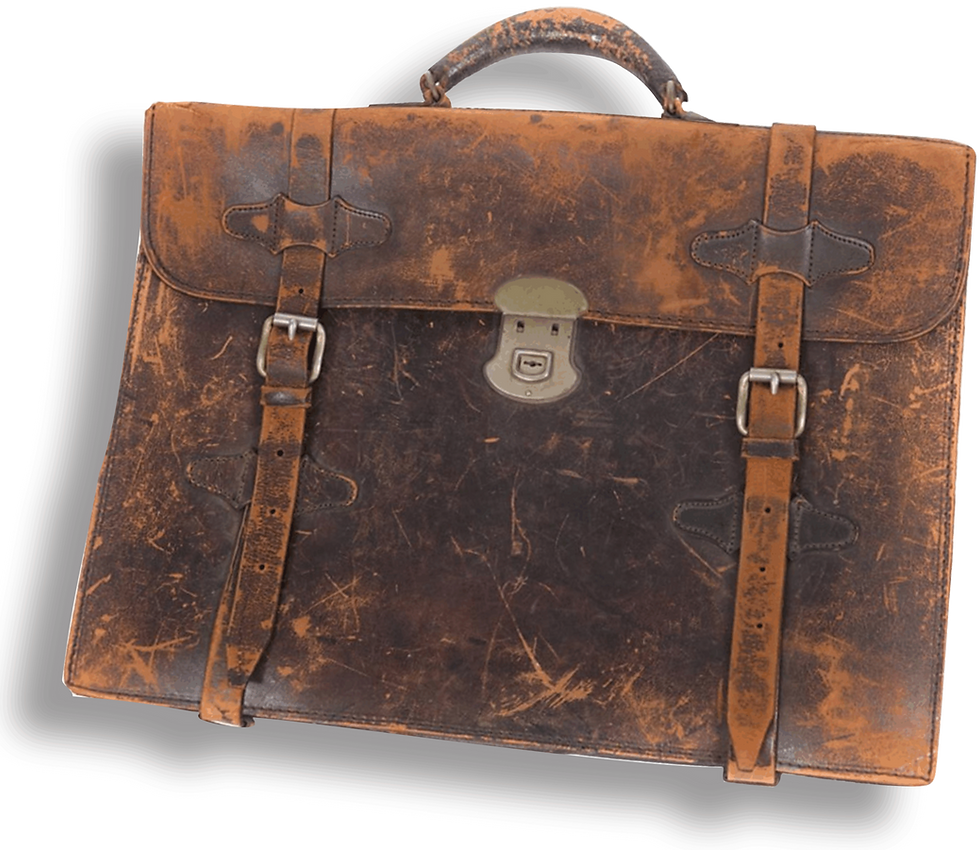
Once she had the valise in her own home, Christine never put it to work in any manner she may have intended when ‘saving’ it, before moving it along with other items into another storage locker, where it remained, again untouched for at least another decade.
When in time, Christine and I prepared to share a home together in Edmonds, Wa…Christine closed out her storage locker and brought all of those stored items, including the valise into our new home.
Late in the evening of our first night in the new house, a first sight of Christine's cool, old valise attracted my attention. All was quiet in the house as I picked up, opened and began to behold it’s UNBELIEVABLE contents for the first time, as all others in my house slept.
The valise had been the vessel for storage of a collection of letters, curated by Christine’s father’s brother, Thornton Thomas for years and years before it came into Christine's possession.
I believe that Thornton initially began at some point in his adult life to collect and preserve old letters written by earlier generations of his family…the ‘Thomases’ and the ‘Waltons’ ...and that over time, Thornton’s friends, knowing of his epistolary arts interest, began gifting him letters of interest to include in his collection. (This idea of mine is partially born out by dated notations on the back of a few of the letters from the contributors to Thornton’s collection.)
The first meticulously preserved and protected notes I began to read that night were the collection's 'Walton and Thomas' letters exchanged mostly during the generation before and including the years of the American Civil War. (some earlier…a few, much later.)
This section of the valise’s treasure is AMAZING. The notes are mostly informal and exchanged between separated family members and make reference to the war….to the horrors of Rubella fever…to the family’s actual westward moving, manifest destiny journeys, etc.
These notes also make it clear that ‘Johns Hopkins’, the great philanthropist, investor and namesake of the famed Baltimore research university…was actually a distant member of Christine’s family. Likewise, ‘Benjamin Moore’, a wealthy, successful merchant known today for the brand of paint that still bears his name, was also related to the Walton/Thomas gang. (And there are wonderful notes from Moore, during his travels, written to his family in the collection.)
But the part of the valise’s contents that I want to make the centerpiece of this writing, are from it’s section featuring notes from several historically significant authors. In this blog post, we'll see and discuss Thornton's collected notes from:
-Enoch Pratt, a world famous industrialist, manufacturer, philanthropist of the 1880s and a friend and contemporary of the famous industrialist, Andrew Carnagie. Pratt's name isn’t as well remembered today as Carnagie's, but his compassionate magnificence has touched me during this research. I can only understand part of Pratt’s note….his handwriting in this quick, informal office-memo is tough to read…So I will ask you to help me to read and make sense of his intent with the note!
-Jack London became one of the first American journalists, war-correspondents and writers of fiction to earn great wealth and celebrity for his writing, which was exceptionally popular throughout the world during his short lifetime. London’s note in our collection is written from his famous Glen Ellen, California, 'Beauty Ranch' dated about 3-1/2 years before his death at 40 years of age. If you know London at all...this note will blow your hair back!!
-America’s 26th president, Theodore Roosevelt wrote his addition to the Thomas/Walton collection just before accepting to serve as US Vice President, under Pr. William McKinley in the year 1900. The dashing, young Veep appears to be desperately trying to avoid an early version of ‘cancel-culture’ by apologizing in our note for an old written remark, which he may have feared could derail his own forthcoming presidential aspirations…
-Marshal Ferdinand Foch was a great general, military tactician of the 19th century and supreme commander of Allied forces during WWI. His tomb is next to Napoleon's at the 'Invalades' in Paris…Foch seems in his note which has come down to our collection, to be managing contributions to his post-WWI charitable association benefitting his wounded war veterans. Here he thanks a writer for her interest in making a significant contribution. If you're a reader of Francais...please give this note a look and let me know your impressions of the General's message!
-Herbert Hoover was America’s 31st President but his path to the presidency (in 1929) was perhaps the most unlikely of all other men who have held the position. Hoover started his career as an engineer immediately after his graduation from Stanford University in 1895; opened his own mining consulting business and held exciting posts throughout the world, living at different times in China, England, Australia and Brazil. At the time of our Hoover note's writing in 1912, the Hoovers lived in London at "Red House" as noted on the invitation card we have that's of his writing.
-The great Physicist, professor and activist Albert Einstein was 62 years of age, living and teaching in Princeton, N.J. when he wrote his contribution to the Thomas/Walton collection in 1942…I'd love to hear your idea of what 'event' he may be referring to in this note returned to a man living across the country from the professor.
-The American scientist, inventor and business magnate, Thomas Alva Edison was 64 years old, when he wrote our collection’s group of desk notes in 1911. He was operating from his ‘Menlo Park’ laboratory and home during this time. A few of the pencil-written notes are written to “Bachmann”, exhorting him to inform, “Thomas” of this or that. I am unable at this time to confirm whether this Thomas is of 'our Thomases' or not….perhaps you can help with this too.
Following are photos of these notes and thoughts about the seven wonderful people who wrote them, along with my thoughts about where each were in their lives at these writings. I hope they fill you with as much awe and reason for further reading and research of these individuals as they have, me!
Let's start with Enoch Pratt
Our note from Mr. Pratt was written during the 78th year of his 88 year life. Pratt earned his fortune as an owner of varied business interests beginning in the 1830s as a 'hardware wholesaler.' Pratt later expanded to railroads, banking, finance, iron works, steamship lines and transportation companies. During his later years, Mr. Pratt was recognized as one of the wealthiest living Americans.
I have found in reading about Mr. Pratt that he was a close friend and sometime, business associate of fellow Baltimore merchant, Johns Hopkins, who we mentioned above as a member of Christine's family and the namesake of the famous Johns Hopkins, University'. This association must explain the presence of Mr. Pratt's note among the collection. Here are photos of Enoch Pratt and his friend Johns Hopkins from about the time Pratt wrote our note...

Enoch Pratt photographed in 1884 Johns Hopkins, 1885
The 'great sorrow' of the life of Mr. Pratt and his wife, 'Maria Louisa Hyde' Pratt, was their inability to have children. Perhaps this led to the great philanthropy the Pratts began to concentrate upon around the time Enoch wrote the note that comes down through the valise to us.
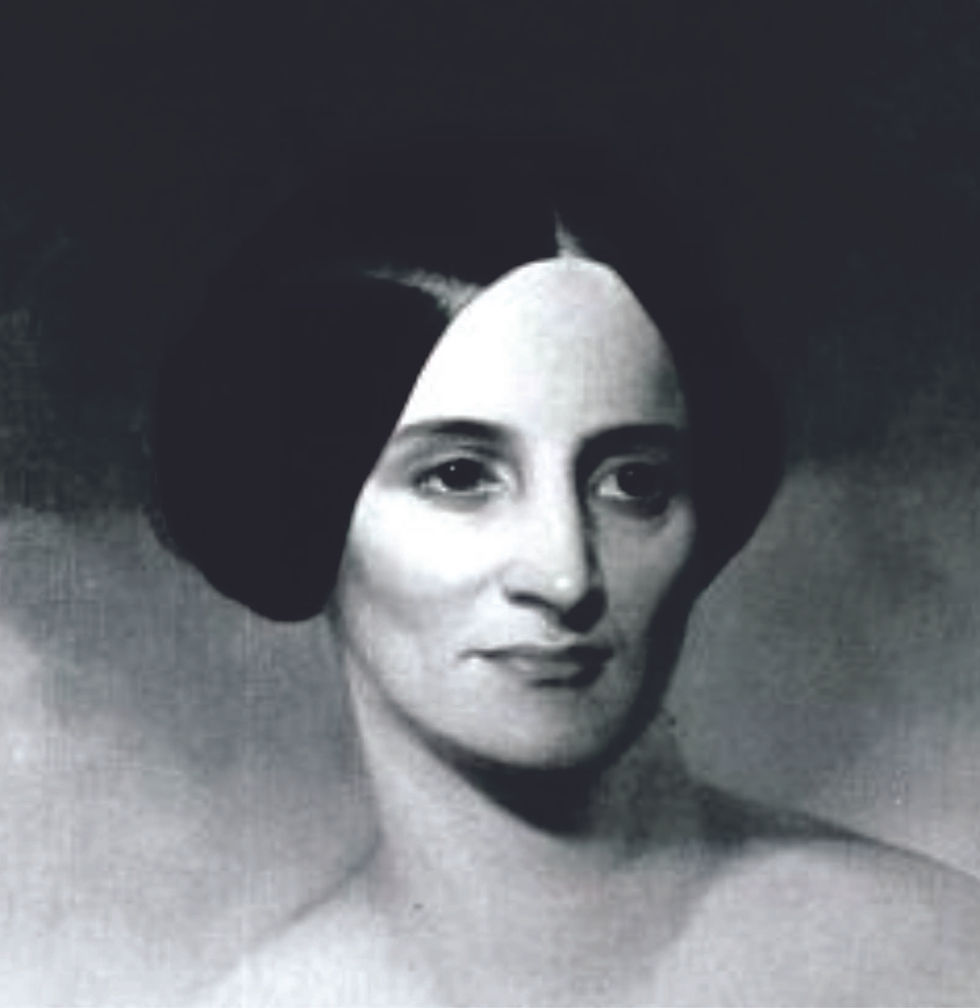
Young, Maria Louisa by the artist, Thomas Buchanan Read, which hangs now in the National Portrait Gallery at the Smithsonian. Isn't she lovely?
Among myriad philanthropic ventures to which the Pratts dedicated their fortune, was their massive creation and perpetual endowment for the "Enoch Pratt Free Library" system.... Several free libraries founded in 1882, and still in operation today in and around Baltimore, Md. The Pratts built and stocked the actual structures and services of the library's buildings and dedicated an endowed for maintaining them in the amount of about $1.8 million1882 dollars, which would be valued at about $550 million in today's dollars . Pratt was quoted as stating of his signature project: “My library shall be for all, rich and poor without distinction of race or color, who, when properly accredited, can take out the books if they will handle them carefully and return them.” A year later, the Pratt's donated 'Cheltenham', a 752-acre tract of land and built and staffed a boarding school there in Prince George’s county, to be used as a reform school for African-American boys, who'd had no such support anywhere in America, previously. Pratt established and ran this effort himself for several years in order to assure his original objectives for it were met. I have to imagine that families like the Pratts were far rarer in their day than now. I have no real idea what it is Pratt is discussing in our short note....but my respect for the man after reading a bit about he and Mrs. Pratt simply wouldn't allow me to leave his note out of this 'report'!
Here's a link to the Enoch Pratt free Library's website:
Home - Enoch Pratt Free Library (prattlibrary.org)
OK! Let's get to the letter!

Here's what I've got:
_____: Oct, 5th 1886
_____ Snowdon & Cowman
I accept your
proposal for (Elevator Car?)
Lombard & Charles Streets
I know nothing of
the items, but repeat
_____ to guarantee it, _____
_____ it unless everything
is equitable ________
Enoch Pratt
No real idea about what's happening here. Pratt seems to be confirming an order to do something on Lombard and Charles streets in Baltimore....and he gives the project the working name, "Snowdon & Cowman"....which is the name of an old Baltimore based maker of Dental Equipment (?) and "foot powered Machinery, used in dental surgery" (??) Snowden and Cowman - Foot Powered Machinery Please help us out here. See if you can fill in some of my 'blanks' or correct any errors you think I have made in my attempt to catch Enoch's meanings here! I have to say, regardless of the missing message in the note....I love a couple of things about it. I love that it's an apparently signed confirmation for action to be taken...It is careful and definitive....and I LOVE the man's signature! Seriously, If you can translate any better than me, please send me a note through the blog or at my email: mrtomlukens@gmail.com I'd love to get clearer on Enoch's meaning here! Jack London was an ATHIEST?!?! Christine and I LOVE this letter from the great American Reporter and Author, Jack London. The short note is on a half sheet of translucent typewriter paper, with a personalized name and address in its upper left corner, which says: "Jack London Glen Ellen Sanoma Co., Cal. USA" This amazing note was written as a response to a man named Fred Brown, who had apparently written to London asking if he was right to assume London, 'an atheist'.

We know from the text that London wrote our letter on his "ranch". This is obviously his beloved, "Beauty Ranch", which was the name he gave to his property of six separate, formerly "bankrupted ranches" where, "...Farmers of the old school have lost their money, broken their hearts and lost their land"...before London purchased the first 130 acres of what eventually became 500 acres, for the sum of $7000.00.
When asked about his reason for assembling his "six bankruptcies" ranch, London commented:
“The challenge to me is this: by using my head, my judgment, and all the latest knowledge in the matter of farming, can I make a success where these men failed? I have pledged myself, my manhood, my fortune, my books, and all I possess to this undertaking.”
The letter we have was post marked, 3-19-1913. London was 36 years of age and only destined to live another 3 years.
Here is the stunningly beautiful note young Jack London wrote on that day from his ranch to a man named Fred M. Brown:

Oh! By the way: irrefragable ir·ref·ra·ga·ble /iˈrefrəɡəb(ə)l/
adjective
1). not able to be refuted or disproved; indisputable.
Note the ghost image of handwriting on the back of the note, visible here at the note's upper right. This is a notation from the note's addressee, 'Fred Brown', bequeathing the document to Thornton's collection, some years after it's writing.
For me...the absolute pearl of thought London devotes here to a meaningful subject matter, for the benefit of a man he'd likely never meet, is GOLDEN. I think he must have been relied upon as a great, compassionate friend to all he knew.
If you don't know much about Jack London, I suggest taking a look at this website: https://jacklondonpark.com/
Teddy avoids c.1900, 'cancel culture'!!
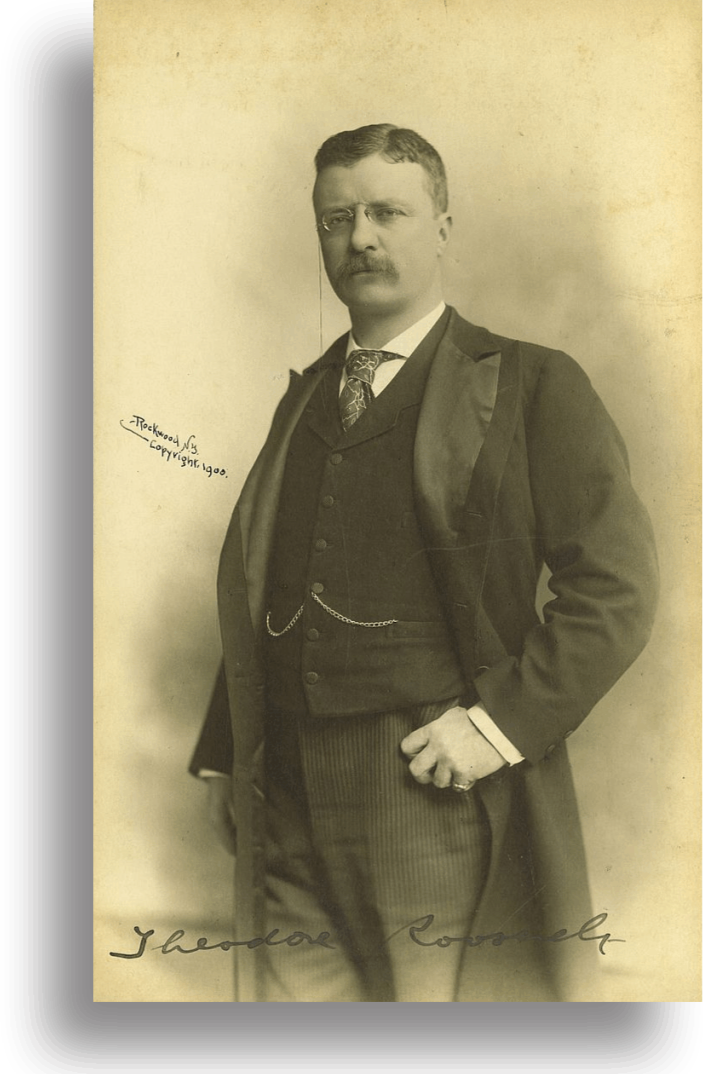
The year was 1900 and Theodore Roosevelt, the dashing, young New York governor was among the most popular politicians in America. The 42 year old, former war hero had plans to run for the presidency after the term of William Mckinley, in the 1904 election...and had, by the date of this letter, begun to prepare for what was certain to be a tough, 'up-hill' political battle.
Note the handwritten mark in the photo at right, which identifies the photo as having been taken the same year our letter (below) was written.
On the date the letter was written, it appears that Roosevelt was in Chicago at the HQ of the Republican National Committee...ostensibly doing some ground work, benefitting his proposed, 1904 presidential run. One of those due diligent tasks is the subject of Roosevelt's letter from Christine's valise, written on October 6th, 1900 as a response to an earlier letter from Mr. William E. Walton, of Baltimore. Without having confirming access to Walton's letter to Roosevelt, it seems Walton may have charged Roosevelt with having (15 years previously) engaged in rhetoric unfairly defaming Walton's 'Quaker' heritage...and Roosevelt herein seeks to address and/or smoothe-over the 'controversial' rhetoric.
Apparently, Roosevelt's earlier commentary, which Walton had seen somewhere in print, had generically labeled Quakers (referred to here by Roosevelt as "the Society of Friends") as, "Non-Combatants"...which Walton perhaps sees as an insult to his sect, comparable to use of a term like, 'cowards'.
Roosevelt refers in his response to a particular "sentence" in his earlier quote that Walton apparently referred to as "offensive to the Society of Friends" in the interview he'd seen somewhere in print. Roosevelt doesn't repudiate this early comment AT ALL...but does complement Walton and Quakers in general...and promises in our letter's text that if he were to now rewrite the quote he'd, "phrase it so that it could not be construed as offensive to the Society of Friends". It's hard to imagine that Walton could really have been very happy with this, 'apology'....but hey! he had his chance to call a national figure onto the carpet AND received a response, which his family has now proudly handed down and cherished for 122 years! My favorite line in this letter is when Roosevelt addresses this earlier, offending sentence by stating that it was intended to: "...express my disagreement both with the man who acts on inadequate provocation, and of the man who on adequate provocation fails to act". I like this because it's poetic and political-legacy-like...but really doesn't SAY anything...particularly to a man, who was apparently driven to action by a comment he saw as insulting of his and his sect's dearest ideals. Things obviously haven't changed much. Roosevelt sought to solve a potential problem, by addressing it and by overtly complementing the group making the complaint...even while basically refusing to change the earlier stance by any measure. Obviously this was enough, as it doesn't seem 'insulting Quakers' ended up harming Roosevelt's career path, going forward. Note that it's a pretty good bet that Roosevelt was visiting the RNC office at this time to discuss his ascendance to the McKinley administration Vice Presidency, which had been vacant since the death of VP, Garret Hobart several months earlier. Roosevelt had made it publicly clear that he wasn't interested in the role...and that those who were promoting his candidacy for the role were really just seeking to lock him into a position that would blunt his appeal to the masses...and therefore assist McKinley in his 1900 run. As it turned out however, Roosevelt DID replace Hobart for the last year of Mckinley's first term and Mckinkey then won the 1900 election with Roosevelt on the ticket. Some six months later, McKinley was assassinated by crazy "anarchist", Leon Czolgosz and Roosevelt became the 26th US president on Sept. 1, 1901. Note also that the William E. Walton receiving Roosevelt's response here IS a member of the Baltimore Waltons, related to Christine's paternal grandmother. I have searched high and low however...and cannot find data/material related to his name. It is certain that the address the letter was sent to is no longer an address...and I am not sure if Walton wrote his letter to the governor in a capacity of Quaker leadership...or just as an indignant Quaker, disgusted with Roosevelt's insulting characterization of Quakers. I will keep looking though...and amend this writing if anything is found.
Here's the letter. Please let me know of any thoughts you may have!

"Vive la Fondation de la Victoire"

Merechal Ferdinand Foch was a great general, military theorist and acted as Supreme Allied Commander during the first world war. Foch won great popularity among the French people after the signing of the Treaty of Versailles, when he famously declared, "This is not peace, it's an armistice which will last only 20 years." The general's words proved prophetic of course, as the second world war began as predicted, 20 years later. Foch also won the love of the French for his determined, continuing support of his 'wounded warriors' after the great war,
when he setup his Fondation de la Victoire which began seeing to the needs of war veterans immediately after the completion of WWI and still operates today.
Great love for Foch from the French public remains visible now in Paris through several honors firmly in place, including a great equestrian statue near the Eifel tower...and a broad boulevard radiating out from the Arc de Triomphe, known as, 'Avenue Foch' and a grand memorial/tomb situated adjacent to that of Napoleon Bonaparte.
Foch's tomb stands alongside that of Napoleon, himself in the great dome of the Invalades, next to the Seine in Paris' 16th arrondissement.

The letter we have from Foch is handwritten on a letterhead from his 'Fondation de la Victoire'...and appears to be a note thanking a woman he refers to only as, "Mademoiselle" for her inquiry about how she can make a 'significant contribution' to the fund.
This letter gave me a chance to try, "google translate" to get an idea of the letter's text. This software allows one to hover a cell-phone camera over foreign text and receive a translated version, immediately. I assume the technology works better for printed type, than for cursive notes, like ours....Here is what 'GT' returned for our Foch note:
VICTORY FOUNDATION MEDICAL ASSISTANCE FOR WIDOWS AND ORPHANS OF WAR OFFICERS
30, Rue du Général Foy, PARIS - VIII. Paris, May 14, 1928
Mademoiselle,
I thank you deeply. I recognize the magnificent (gesture?) that you wanted to (make?) through the Fondation de la Victoire and I am addressing you on behalf of the committee, as we are pleased to express our profound gratitude, we deeply appreciate the interest you wish to take in this Muse Venibly(?) and (please) accept, Mademoiselle, the expression of my deepest feelings recognize and the most destined.
~Le Merichele Foch
Here is the actual note:


Hoover this!
Herbert Hoover is underappreciated, I think. Most people know of the 31st American president as the guy responsible for the 'Great Depression', or as a rich Republican with no compassion for working Americans, etc. But I think its an injustice that this brilliant and magnificent man's legacy is derisively remembered for the tent-cities desperate Americans occupied during the Depression, referred to as, "Hooverville".
Here is a photo of Hoover taken in 1912, the same year as the date on the short note in the Walton/Thomas collection...when the future president was 37 years of age.
The Herbert Hoover note we have here is an invitation to Mr. R. H. Thomas and wife to visit Mr. and Mrs. Hoover at their "Red House" in London to "dine at 8PM" on the date following the date of the note.
I guess we can assume that R. H. Thomas is a member of the Walton/Thomas family, and therefore, a Christine-relative...but again, no information is easily available for R. H. and wife.
I'll amend this writing if any material makes itself available.
Hoover, who had been a graduate of Stanford University in 1895 was also a Quaker...which MAY explain the association to the R. H. Thomases. After graduation, Hoover accepted a geologist position with a mining company that sent him to its gold mines in western Australia. His rapid and impressive successes in his employer's name made him a partner in the lucrative enterprise within a year. Hoover repeated his Australia successes in China, Burma, Mandalay, while opening offices for his mining company services in Paris, New York, San Francisco and London. Hoover was a multi-millionaire by his early 30s.
When WWI broke out, Hoover was working and living in Belgium. Unable to operate his company's mines during the war, Hoover concentrated upon delivering relief to Americans stranded in Europe due to the war. When Germany invaded Belgium in 1914, Hoover established the Commission for Relief of Belgium (CRB) and basically fed all of that state's citizenry after seeking and securing funds of over US$11 million per month for the task. The program was a giant success, which caught the attention of the Woodrow Wilson Administration and in affect, started Mr. Hoover's public career...as the Wilson appointed, first head of the U.S. Food Administration.
When our note was written, however, it was 1912 and the Hoovers were living in London's "RED HOUSE" (shown in a contemporary photo, below), while Hoover administered to his mining consultation firm. I guess his firm must have rented the house for it's leader's family. And by the looks of the house, itself, I gather that the firm must have been 'doing pretty well'.

The Thackery Hotel where the Thomases were staying and received their invitation from Hoover, WAS the best hotel in London at the time...but sadly, no longer exists. Here is a photo post card with a rendering...Best I could find:

Here's the simple typewritten note inviting the Thomases to dinner at Red House. I would guess that it was typed by a company secretary, then brought to Hoover for his pencil'd signature.
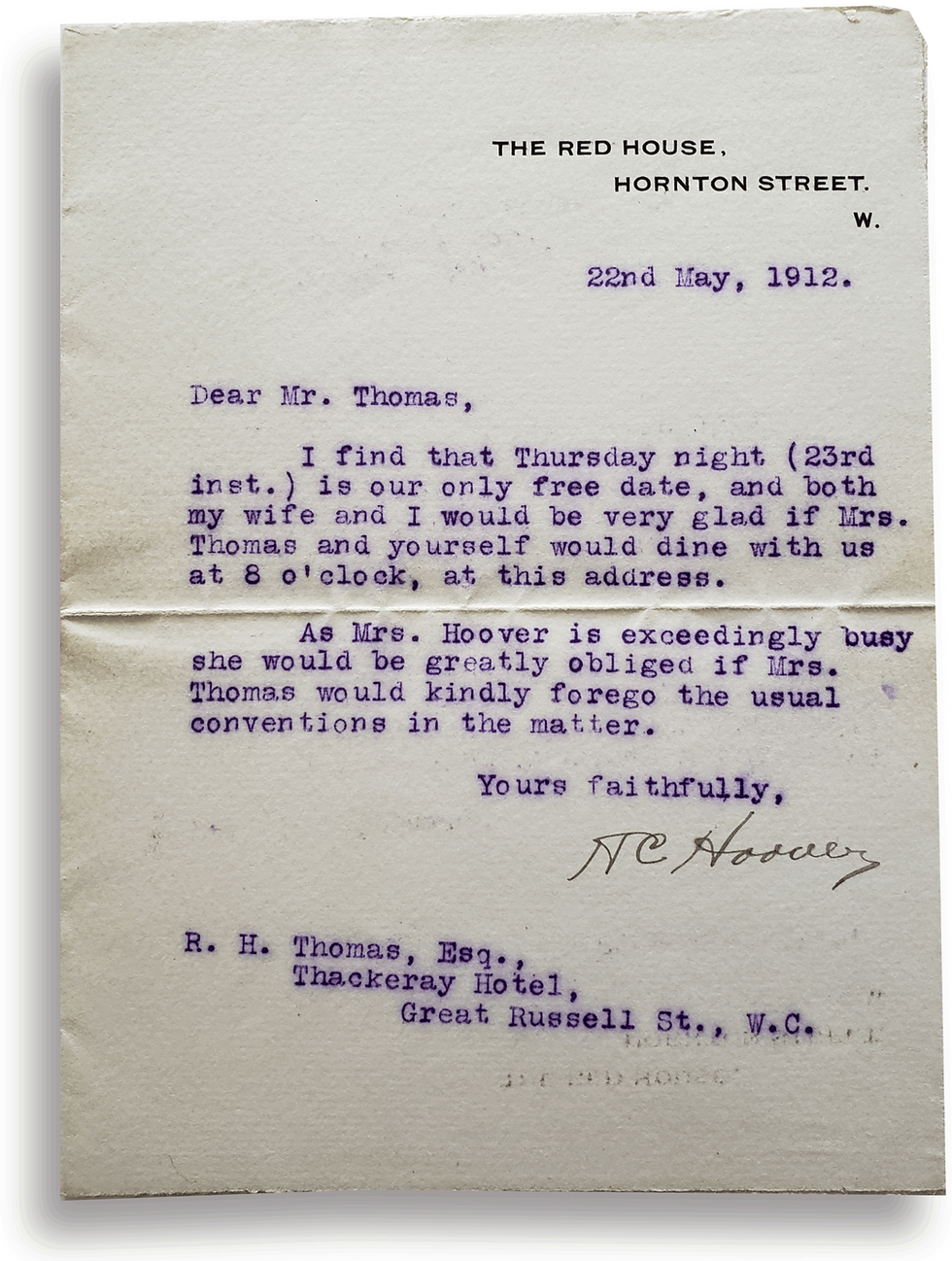
Albert's, "influence"

Just about everybody in the world owns some kind of idea of who Albert Einstein was, and how his legendary intellect has forever-after effected the world he was born into.
When the great physicist wrote his letter to, 'Mr. Fredrick Merritt', which has found it's place in Christine's valise, he was 62 years of age and was working in a tiny mathematics dept. office on the campus of Princeton University, in Princeton N.J. The photo shown here was taken in 1906 around the time the young genius had published his famed, Theory of Relativity and was just beginning to live a life of celebrity, which would persist the remainder of his days. When Einstein wrote the note we share here below, he did so from his home on the Princeton campus at the house shown below. Note the embossed address on our letter...and the famous, "fuzzy slippers" photo taken on the front porch...probably some time after our letter's date.

Please note also that the DATE of our letter is also MY BIRTHDAY....although, 17 years before my birth year. Here below is the magnificent letter in it's entirety, which I know Christine counts among her very most treasured possessions. Please read through and let me know your thoughts about the events you think the two men are discussing here!
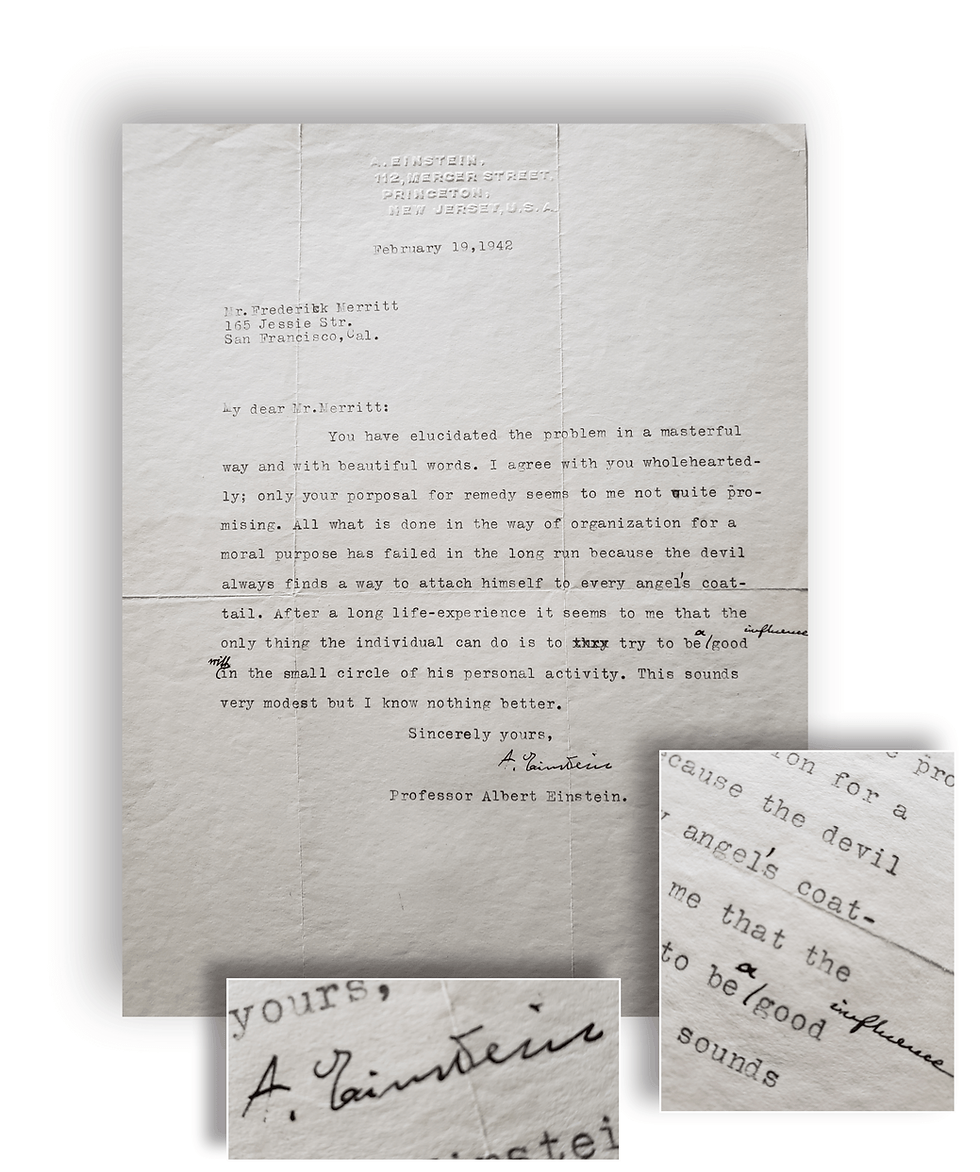
We have a lot of these older-era letters in our collection, as you know...and this one follows the example of several informal, typewritten notes, which include handwritten corrections. I kinda' LOVE the personal touch this practice adds to a note, particularly one written by a singularly famous individual, like Einstein.
It's tough to know what "event" Dr. Einstein speaks of in our note to Mr. Merritt...but, given the date and what we know about his politics...I have to believe it has to do with a subject he was then becoming increasingly defined by: His denunciation of the idea of any world state conducting nuclear warfare.
On the eve of U.S. involvement in WWII, Einstein had endorsed a scientific community letter sent to U.S. President Franklin Roosevelt, warning of probable, ongoing German nuclear weapons research (at least). The letter, co-signed by Oppenheimer and others, suggested the president should begin similar research immediately, although resisted suggesting actually beginning to develop nuclear weapons. After the Roosevelt letter and the national discussion it produced, Einstein became increasingly associated in the press to an effort to avoid committing to design and development of nuclear warheads. I can imagine that by February of 1942, Mr. Merritt had become aware of Einstein's position of opposition to nuclear warfare and sought to budge the professor's mindset in some slight measure with his letter to him....Which Einstein then tells Merritt he didn't find, "a promising solution".
But...as with all of these letters...I would LOVE to hear your own ideas about the great scientist's motivation for his note to Mr. Merritt!
-Here's a link to an article about that letter sent to FDR: The Lesson of Einstein's Warning to FDR on Nuclear Weapons | Time
-Here's a link to an article offering an Einstein letter, typed on the same letterhead as ours for nearly US$50k!: 1948 Einstein letter of warning to Israeli president being sold | The Times of Israel
One more: This is a nice informative piece about the Einstein house: Albert Einstein – Historical Society of Princeton (princetonhistory.org)
Bachman, Thomas and Edison!
Like professor Einstein, Thomas Alva Edison is an historical figure, just about everybody knows something about. When the great inventor wrote his simple, instructive desk notes in 1911 (below) that survive in the Thomas/Walton collection, he was probably the most famous living American...or perhaps, the most famous man in all the world.

The notes were written in the vast, then new-ish lab complex Edison had built in Orange, New Jersey that survives today as the "T.A. Edison National Historic Park".
The notes are written on what appear to be pages torn from a 'prefect bound' desk pad...always in pencil and always signed either "Edison" or signed off as, "TAE".
Here is a colorized photo of the great inventor, taken outside the Orange, N.J. location in the same year as the notes are dated. Edison was 64 years of age.
The notes each mention a, "Thomas", who I choose to believe is, "E.W. Thomas", a man remembered alongside Edison in many bibliographies easily found today on the web...and it MUST be Thomas, who is also perhaps a member of our Walton/Thomas crew, responsible for Christine's family's inheritance of the notes. Here's a photo taken in 1893, outside Edison's 'Menlo Park Lab' (which later became the Orange, facility) showing the great man and his, "Muckers"...a term Edison used to describe his large staff of researchers. E.W. is oft-mentioned, but this is the only photo I could find of Edison's obviously very highly regarded and long associated aide.

In addition to 'Thomas', the name "Bachman" is mentioned in each of our notes. It seems to me that Mr. Bachmann, who is also often mentioned in web accounts as a long time Edison associate, may have functioned as something of a Mucker-Supervisor or as a manager of the lab, perhaps. In the photo below, 'Bachman' is identified as R.H. Bachman (also sometimes as Robert Bachman) and he's included here as a dais-guest at Mr. Edison's 70th birthday party. That Bachman has been seated next to the great industrialist, Henry Ford at the event, seems to speak of the importance of the position he held in Edison's enterprises.

Here below is a photo of Edison entertaining a visitor at his working desk at the Orange, N.J. facility. There are enough photos of the great man sitting at this same over-stuffed desk that I am confident assuming our notes may have been written as he sat here, as well. Note the attached photo of 2 desk notes taken from the web, very similar to ours but dated 10 years later. I think Edison used this means of micro-managing the details and the many people (over 1000 were employed at the Orange lab in the late 19-teens) facilitating his many concurrent projects, decade after decade.
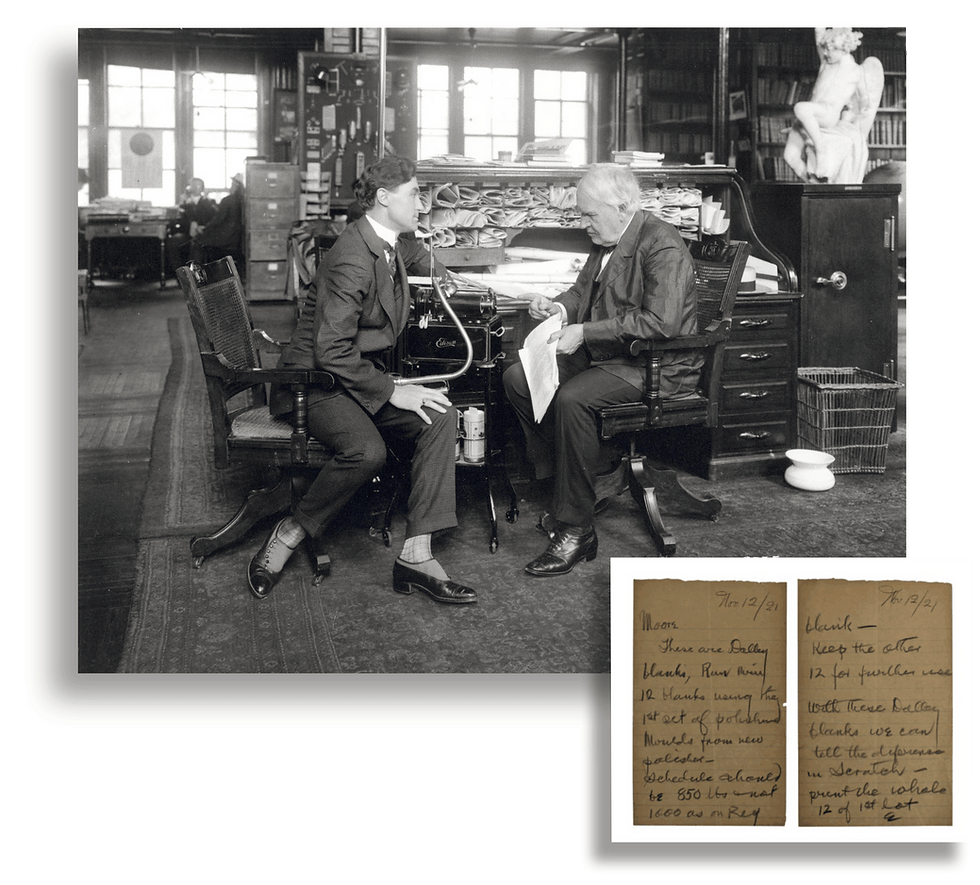
Here are our Thomas Alva Edison desk notes below. Read through them and I am pretty sure you'll find them as exciting as I find them. Look at the upper left note, wherein Edison demonstrates absolute, 'underlining' excitement over a simple solution he suggests, to the apparently banal problem of "oil creating a scum that coats a drum". Gotta love that kind of dedication!
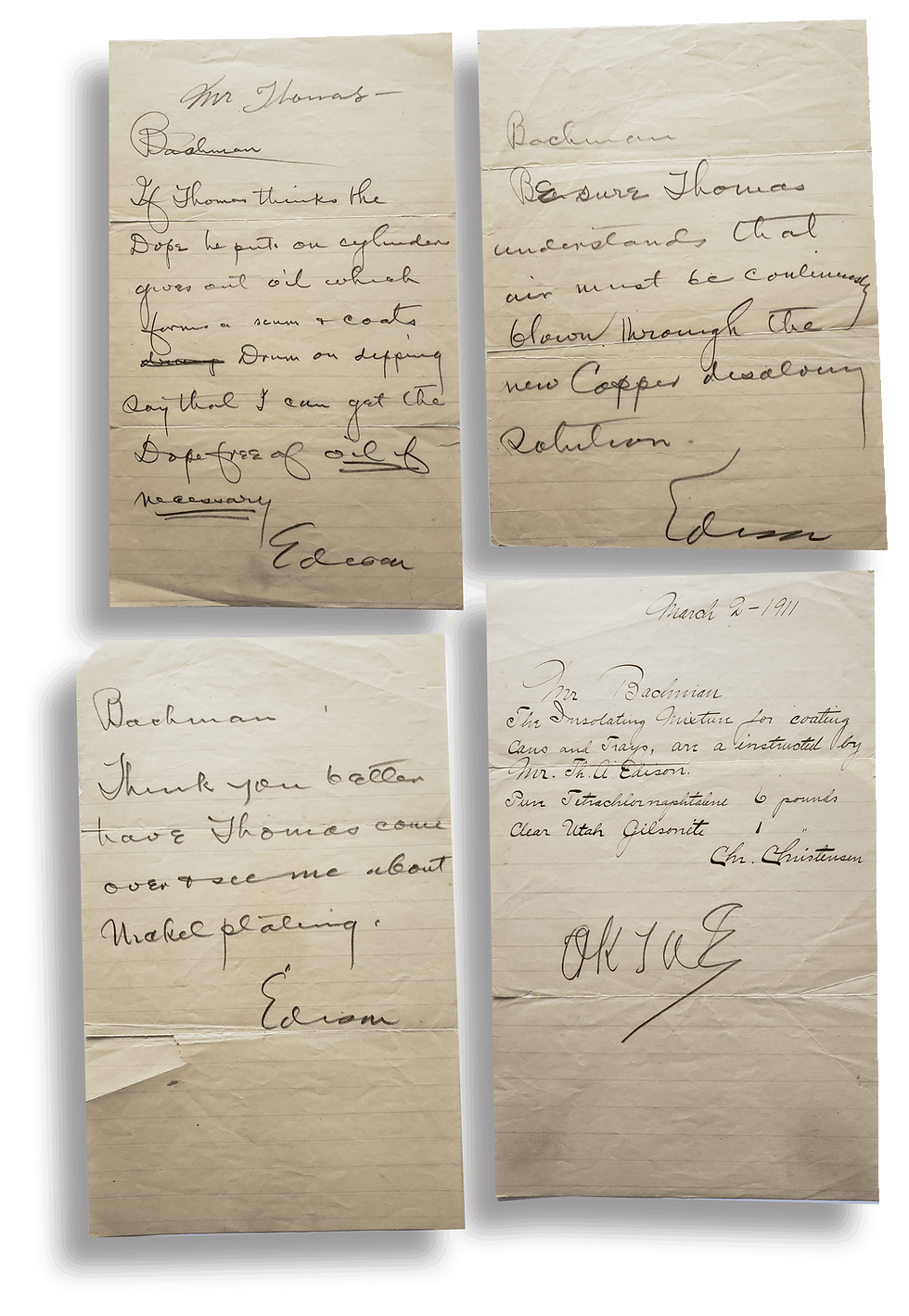
Well...that's it for this edition of, 'This Just In'. This one has been a fun one for me to research and write and, as always I invite and look forward to your thoughts on these subjects. As I wrap this writing, I have to comment upon the REMARKABLE family that's lovingly treasured and kept these documents through the generations since they originally collected them. The Waltons and Thomases are obviously very special people. Most of this stuff is in their possession owing to actual, significant associations to these great minds over a long, long period and that's NO mistake. From actual familial relation to Johns Hopkins and Benjamin Moore, to a close friendship with Hoover and as trusted associates to Edison, the family has remained intimately close to greatness. I am happy to say that I know just about ALL of this family's current crop, and they are EACH magnificent of their own right and upholding the intellectual legacy they have inherited! "Excellence is not an act, but a habit....We ARE what we repeatedly do." ~Aristotle
T.
Here's a bonus....Like after one of those superhero films, where you have to wait until the end of the credits, then Samuel L. Jackson comes out and gives you some kind of clue for the next film.....

This actually comes to us through the Thomas/Walton treasure chest too! No clue as to who the artist might be...but my money is on Thornton Thomas, himself...without whom this post would be impossible! Thanks T!
Comments